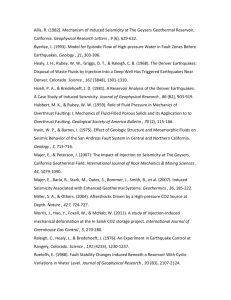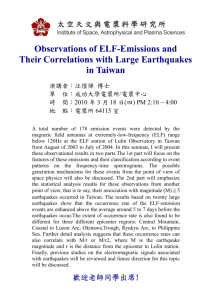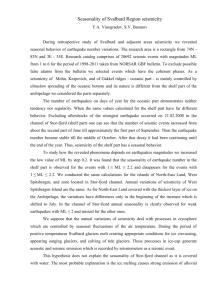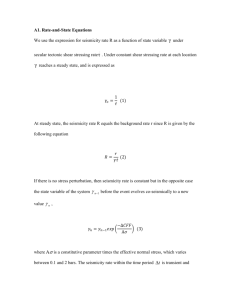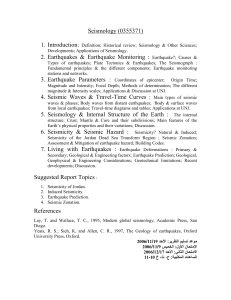Moderate-Magnitude Seismicity Remotely Triggered in the Taiwan Region
advertisement
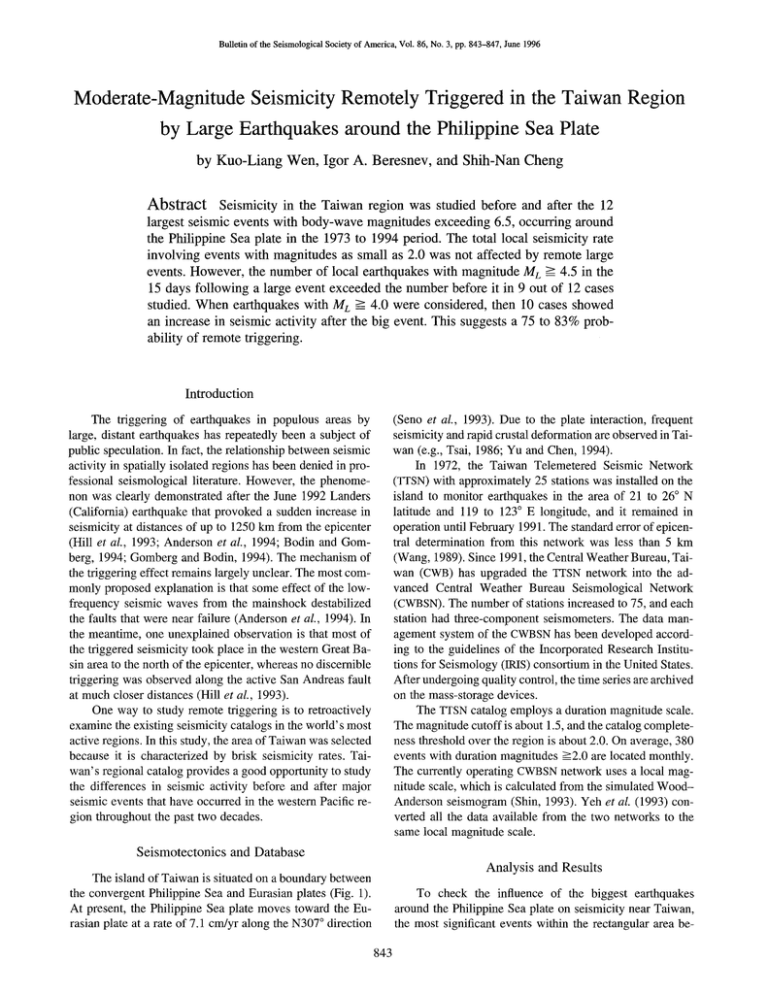
Bulletin of the Seismological Society of America, Vol. 86, No. 3, pp. 843-847, June 1996 Moderate-Magnitude Seismicity Remotely Triggered in the Taiwan Region by Large Earthquakes around the Philippine Sea Plate b y K u o - L i a n g W e n , I g o r A. B e r e s n e v , a n d S h i h - N a n C h e n g Abstract Seismicity in the Taiwan region was studied before and after the 12 largest seismic events with b o d y - w a v e magnitudes exceeding 6.5, occurring around the Philippine Sea plate in the 1973 to 1994 period. The total local seismicity rate involving events with magnitudes as small as 2.0 was not affected by remote large events. However, the number o f local earthquakes with magnitude ML -------4.5 in the 15 days following a large event exceeded the number before it in 9 out of 12 cases studied. W h e n earthquakes with ML >----4.0 were considered, then 10 cases showed an increase in seismic activity after the big event. This suggests a 75 to 83% probability o f remote triggering. Introduction The triggering of earthquakes in populous areas by large, distant earthquakes has repeatedly been a subject of public speculation. In fact, the relationship between seismic activity in spatially isolated regions has been denied in professional seismological literature. However, the phenomenon was clearly demonstrated after the June 1992 Landers (California) earthquake that provoked a sudden increase in seismicity at distances of up to 1250 km from the epicenter (Hill et al., 1993; Anderson et al., 1994; Bodin and Gomberg, 1994; Gomberg and Bodin, 1994). The mechanism of the triggering effect remains largely unclear. The most commonly proposed explanation is that some effect of the lowfrequency seismic waves from the mainshock destabilized the faults that were near failure (Anderson et al., 1994). In the meantime, one unexplained observation is that most of the triggered seismicity took place in the western Great Basin area to the north of the epicenter, whereas no discernible triggering was observed along the active San Andreas fault at much closer distances (Hill et al., 1993). One way to study remote triggering is to retroactively examine the existing seismicity catalogs in the world's most active regions. In this study, the area of Taiwan was selected because it is characterized by brisk seismicity rates. Taiwan's regional catalog provides a good opportunity to study the differences in seismic activity before and after major seismic events that have occurred in the western Pacific region throughout the past two decades. (Seno et al., 1993). Due to the plate interaction, frequent seismicity and rapid crustal deformation are observed in Taiwan (e.g., Tsai, 1986; Yu and Chen, 1994). In 1972, the Taiwan Telemetered Seismic Network (TTSN) with approximately 25 stations was installed on the island to monitor earthquakes in the area of 21 to 26 ° N latitude and 119 to 123 ° E longitude, and it remained in operation until February 1991. The standard error of epicentral determination from this network was less than 5 km (Wang, 1989). Since 1991, the Central Weather Bureau, Taiwan (CWB) has upgraded the TTSN network into the advanced Central Weather Bureau Seismological Network (CWBSN). The number of stations increased to 75, and each station had three-component seismometers. The data management system of the CWBSN has been developed according to the guidelines of the Incorporated Research Institutions for Seismology (IRIS) consortium in the United States. After undergoing quality control, the time series are archived on the mass-storage devices. The TTSN catalog employs a duration magnitude scale. The magnitude cutoff is about 1.5, and the catalog completeness threshold over the region is about 2.0. On average, 380 events with duration magnitudes _-->2.0are located monthly. The currently operating CWBSN network uses a local magnitude scale, which is calculated from the simulated WoodAnderson seismogram (Shin, 1993). Yeh et al. (1993) converted all the data available from the two networks to the same local magnitude scale. Seismotectonics and Database Analysis and Results The island of Taiwan is situated on a boundary between the convergent Philippine Sea and Eurasian plates (Fig. 1). At present, the Philippine Sea plate moves toward the Eurasian plate at a rate of 7.1 cm/yr along the N307 ° direction To check the influence of the biggest earthquakes around the Philippine Sea plate on seismicity near Taiwan, the most significant events within the rectangular area be843 844 K.-L. Wen, I. A. Beresnev, and S.-N. Cheng 120"E 195" 110 I l 120 130 140 150 35 CHINA MAINLAI 25 / 30 *N I I I I I I 25 , f" 'l l )3 EURAE PLA" |l i "' ~ ! _,_ _:?_ _ _ _ - - : __- ..... _~(3r2_o. . . . . _J. . . . . . . . . ' I ~, . . . . . . © 8 20 , 15 20 ° I L------ t I I L. . . . . . . . . . . . . I i • ~"-~1 1 10 I ~ 15 ° Figure 2. Epicenters of the largest earthquakes with mb ~ 6.5 occurring from 1973 to 1994 around the Philippine Sea plate. The circle size scales with the magnitude. Event numbers correspond to Table 1. The rectangular area shows the study area where seismicity was counted. Figure 1. Plate-tectonics setting of Taiwan and the neighboring regions, showing the interaction of the Philippine Sea and Eurasian plates with the Ryukyu arc system, developed to the east and northeast of Taiwan, and the Luzon arc system extending to the south (after Ho, 1986). tween (5 ° N, 35 ° N) and (110 ° E, 150 ° E) were searched in the Preliminary Determination of Epicenters catalog (PDE). In the period from 1973 to 1994, 12 events with body-wave magnitudes mb >----6.5 occurred in the study area. The epicenters of these events are shown in Figure 2, and other parameters are listed in Table 1. The epicentral distances shown in the last column of Table 1 are related to the reference point at (24 ° N, 121° E) in Taiwan. Except for number 12, all events were interplate earthquakes located around the Philippine Sea plate. Events 2 and 3 were very close to Taiwan. Others were as far as 3000 km away from the island. To test for the possibility of remote triggering, the 30day cumulative seismicity was calculated from 15 days before to 15 days after each large event in Table 1. The interval o f 15 days was inferred from the maximum delay in the appearance of triggered events as reported in the studies of the Landers phenomenon (Hill et al., 1993; Anderson et al., 1994). All the earthquakes with ML ---->2.0 occurring within the local rectangular study area shown in Figure 2 were counted in the cumulative seismicity value. This local study area of 135,000 km 2 is defined by (21.5 ° N, 119.5 ° E) and (25.5 ° N, 122.5 ° E). The TTSN and CWBSN catalogs were used for the periods from 1973 to February 1991 and March 1991 to 1994, respectively. It should be noted that the aftershocks of a big earthquake are related to the same causative fault and cannot be regarded as remotely triggered. Hence, for events 2 and 3, Table 1 Large Earthquakes Used in This Study Event No. Date (d m yr) 1 2 3 4 5 6 7 8 9 10 11 12 7 Mar 78 23 Jul 78 23 Dec 78 6 Sep 82 1 Jan 84 5 Mar 84 18 Sep 84 16 Sep 86 5Apr90 16 Jul 90 8 Aug 93 16 Sep 94 Origin time (hr:min) 02:48 14:42 11:23 01:47 09:03 03:33 17:02 18:20 21:12 07:26 08:34 06:20 Coordinates Lat.(°) 32.005 22.282 23.247 29.325 33.683 08.147 34.006 19.376 15.125 15.679 12.982 22.567 Long.(°) Depth (kin) mb A* (kin) 137.609 121.512 122.075 140.360 136.894 123.762 141.500 146.301 147.596 121.172 144.801 118.716 439 17 33 175 368 649 47 47 11 25 59 10 6.9 6.5 6.6 6.5 6.5 6.5 6.6 6.5 6.5 6.5 7.1 6.5 1859 197 138 2016 1886 1779 2285 2668 2959 921 2794 282 *Epicentral distances (A) are related to the referent point of (24° N, 121° E). whose epicenters were within the local rectangle, the respective "source exclusion zones" were introduced, and all the earthquakes with epicenters within this zone were excluded from the analysis. Because these two events took place offshore, their exact fault dimensions are unknown. As established in the seismic hazard analysis for nuclear power plants in Taiwan (EIE, 1984), the relationship between the rupture length and the local magnitude indicates fault lengths Moderate-Magnitude Seismicity Remotely Triggered in the Taiwan Region by Large Earthquakes around the Philippine Sea Plate 845 ~ ~" ~ E ~EE ~ e~ ~ mm p.=J¢ ~=~ =Z 300 / ~ 552 375 Z Z ==Z / / Z // / / ; / ~ 0 ¢,, 0 - J d 15 Time(days) 30 0 ,,,,ll= 15 Time (days) 0 E ~E E et =,,,1~ 30 Time *~ ~ I E ~o 15 (days) 30 ~ ~EE ¢o 4 6 / 272 507 421 I / J z •> J f / d J (J ,,,,i,, 15 Time(days) EE JcJ¢ 7 qR ~ 4 == ,,,,,= 30 0 '' 0 i 15 Time (days) ~ ~e~E ~ . J¢ ;¢J¢ I .... 30 8 -= 0 15 (days) Time E =: 4 4 6 q 4 f J 0 / 0 S Z / 0 / m EEE J¢J< J¢ ~ 652 30 ® o~ ¢>ol 9 / 189 ,/I J~ Z Z @ ,> I(I r w f 8 o~, ........... I.... L....... 0 15 Time (days) 0 30 O o/,I .......... L,,I ...... ! 0 EE 10 15 Time (days) ~EE 30 '/ n Z z 30 EE EEE E~EEEEE 12 228 ?, 15 Time (days) ¢o 11 ~ 338 O 1 fl I ~" / / .>=_ -5 E 8 8 ~ 1 0 15 Time (days) Figure 3. 30 0 15 Time (days) 30 0 t I t I I I [] I 15 Time(days) Seismicity in the 15 days before and after each big event. The vertical lines show the occurrence of M L _--__4.5 earthquakes. 30 846 K.-L. Wen, I. A. Beresnev, and S.-N. Cheng of about 15 and 26 km for events 2 and 3, based on their local magnitudes of 6.3 and 6.7, respectively. A "source exclusion zone" is then defined as a circle with a radius of 50 km around an epicenter. As an additional statistic, the number of earthquakes with M L -----4.5 in the same time interval was examined. Figure 3 presents the cumulative regional seismicity curves for the local study area and for all 12 large reference earthquakes. The total cumulative number in the 30-day period varies from about 190 to 880. The origin time of the reference event is shown by the thick vertical line in the center of each plot. The thin lines indicate the origin times of M L ->_4.5 quakes in the local Taiwan area. The numbers above them represent their magnitudes and distances from the reference event. All the plots in Figure 3 show that the behavior of the overall cumulative seismicity is not affected by the big events. However, the opposite is valid when only ML ~ 4.5 earthquakes are considered. Table 2 summarizes the number of earthquakes in the 15-day period before and after each reference event. In 9 of the 12 cases, the number after the reference event exceeds the number before it by 1 to 4. Only events 2, 5, and 9 are exceptions. The results for ML >----4.0 seismicity are also listed in Table 2. In 10 of the 12 cases, the number of ML >=4.0 earthquakes recorded after the big event exceeds the number of those occurring before it by 1 to 7 (except events 5 and 7). Discussion Some of the additional earthquakes occurring after a big event could have been remotely triggered, whereas some of them may have been unrelated. There is no way to differentiate the triggered from the unrelated events. Hence, it can only be asserted that, in the average sense, more events occur after the big one than in the same time interval before it. By randomizing the data presented in Table 2, the probability of the observed increase in seismicity occurring by random chance can be estimated. From Table 2, a set of 24 numbers of earthquakes observed in 15-day periods (1, 2, 1, 1, 0, 3, etc. for the ML ----4.5 seismicity, and 2, 4, 4, 10, 2, 5, etc. for the ML ---->4.0 seismicity) was randomly recorded into 12 "earthquakes before" and "earthquakes after" pairs. By doing this 10,000 times, it was determined how often N sequences showing an increase (more events in the "earthquakes after" pick) were found by chance. In this way, it was found that for the ML ---->4.5 seismicity, N >---8 occurs 6% of the time and N -----9 sequences occurs only 2% of the time. For the ML -> 4.0 seismicity, it was found that N --> 8 occurs 9% of the time, N _-->9 occurs 2% of the time, and N _-->10 can occur by chance just 0.5% of the time. Thus, with about 98% confidence in the first case and about 99.5% confidence in the second case, the hypothesis that what is observed is purely random must be rejected. Table 2 N u m b e r o f E a r t h q u a k e s before and after the B i g E v e n t s ML~ 4.5 ML-->_4.0 Event Earthquakes Earthquakes Earthquakes Earthquakes No. Before After Difference Before After Difference 1 2 3 4 5 6 7 8 9 10 11 12 1 1 0 0 3 1 3 0 2 2 2 4 2 1 3 1 1 3 4 4 2 5 4 5 +1 +0 +3 +1 -2 +2 + 1 +4 +0 +3 +2 +1 2 4 2 0 8 4 10 4 6 6 9 7 4 10 5 7 7 6 6 6 7 9 13 12 +2 +6 +3 +7 -1 +2 -4 +2 +1 +3 +4 +5 Conclusions Regional seismicity catalogs in Taiwan were used to study the variations in local seismicity possibly associated with the 12 largest earthquakes occurring in the western Pacific region over a 22-year period. Cumulative local seismicity was counted over 15-day intervals before and after each large reference event. The local small-magnitude activity (between ML = 4.0 and approximately 2.0) did not seem to respond to the occurrence of a very large event. However, in 9 of the 12 cases studied, the number of ML -------4.5 earthquakes recorded after the big event exceeded their number before it by 1 to 4. Similarly, 10 of the 12 cases exhibited an increase in the ML -->--4.0 seismicity by 1 to 7. This suggests that the probability that a large earthquake causes an increase in remote moderate-magnitude seismicity is 75 to 83%. The probability of this occurring by random chance was shown to be negligible. The authors propose that this increased activity is a remote triggering effect, similar to that observed after the 1992 Landers (California) earthquake. According to the data, the remote triggering effect may be observed, on average, up to the distances of 3000 km, i.e., the largest distances available in this study. Acknowledgments The authors thank Dr. Honn Kao who set up the PDE catalog in their computer system and Dr. Bor-Shouh Huang for providing assistance in the use of the MAP program of the IRIS Data Management Center. Helpful suggestions and criticism by the Associate Editor Prof. Martin C. Chapman and the anonymous reviewers improved the clarity of the article. This work was supported by the Institute of Earth Sciences, Academia Sinica. References Anderson, J. G., J. N. Brune, J. N. Louie, Y. Zeng, M. Savage, G. Yu, Q. Chen, and D. dePolo (1994). Seismicity in the western Great Basin apparently triggered by the Landers, California, earthquake, 28 June 1992, Bull Seism. Soc. Am. 84, 863-891. Moderate-Magnitude Seismicity Remotely Triggered in the Taiwan Region by Large Earthquakes around the Philippine Sea Plate Bodin, P. and J. Gomberg (1994). Triggered seismicity and deformation between the Landers, California, and Little Skull Mountain, Nevada, earthquakes, Bull. Seism. Soc. Am. 84, 835-843. EIE (1984). Seismic hazard analysis of Taiwan Power Company's nuclear power plant No. 2 at Kuosheng, Report to AEC, R.O.C., Eastern lnteruational Engineers, Inc. Gomberg, J. and P. Bodin (1994). Triggering of the M s = 5.4 Little Skull Mountain, Nevada, earthquake with dynamic strains, Bull. Seism. Soc. Am. 84, 844-853. Hill, D. P., P. A. Reasenberg, A. Michael, W. J. Arabasz, G. Beroza, J. N. Brune, D. Brumbaugh, R. Castro, S. Davis, D. dePolo, W. L. EllsworttL J. Gomberg, S. Harmsen, L. House, S. M. Jackson, M. Johnston, L Jones, R. Keller, S. Malone, L. Munguis, S. Nava, J. C. Pechmann, A. Sanford, R. W. Simpson, R. S. Smith, M. Stark, M. Stickney, A. Vidal, S. Walter, V. Wong, and J. Zollweg (1993). Seismicity in the western United States remotely triggered by the M 7.4 Landers, California, earthquake of June 28, 1992, Science 260, 16171623. Ho, C. S. (1986). A synthesis of the geologic evolution of Taiwan, Mere. Geol. Soc. China 7, 15-29. Preliminary Determination of Epicenters Monthly Listing (PDE), U.S. Department of the Interior/Geological Survey, National Earthquake Information Center. Seno, T., S. Stein, and A. E. Gripp (1993). A model for the motion of the Philippine Sea plate consistent with NUVEL-1 and geological data, J. Geophys. Res. 98, 17941-17948. Shin, T. C. (1993). The calculation of local magnitude from the simulated Wood-Anderson seismograms of the short-period seismograms in the Taiwan area, Terr. Attn. Ocean Sci. 4, no. 2, 155-170. 847 Tsai, Y. B. (1986). Seismotectonics of Taiwan, Tectonophysics 125, 1737. Wang, J. H. (1989). The Taiwan telemetered seismographic network, Phys. Earth Planet. Interiors 58, 9-18. Yeh, Y. T., S. N. Cheng, C. Lee, C. C. Shin, and C. C. Chen (1993). Judgment of earthquake location and magnitude of several catalogues in the Taiwan region, Technical Report of the Seismology Center, Central Weather Bureau, Ministry of Transportation and Communications, Taiwan, R.O.C., V4-1, 1-23. Yu, S. B. and H. Y. Chert (1994). Global positioning system measurements of crustal deformation in the Taiwan arc-continent collision zone, Terr. Atn~ Ocean Sci. S, no. 4, 477--498. Institute of Earth Sciences Academia Sinica P.O. Box 1-55, Nankang Taipei, Taiwan 11529 R.O.C. (K.L.W., S.N.C.) Department of Earth Sciences Carleton University 304 Tory Building 1125 Colonel By Drive Ottawa, K1S 5B6 Canada (I.A.B.) Manuscript received 8 May 1995.

